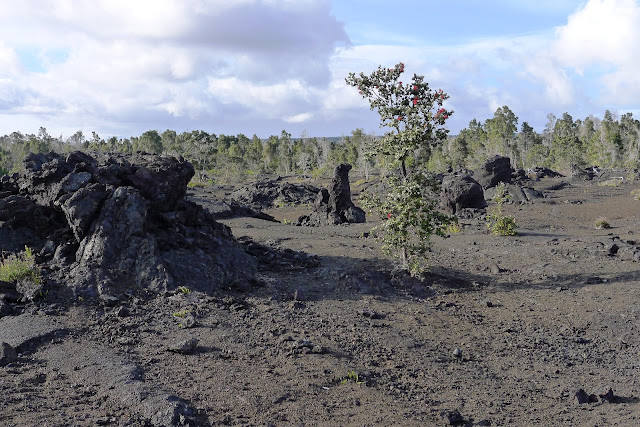We arrived in Hilo on the island of Hawaii at 11:00 AM, sighting humpback whales as we approached the harbor.
Pele is the goddess of fire, so the volcano is her domain.
Don't be deceived by what appears to just be some smoke, Kilauea is most definitely an active volcano - currently the most continuously active volcano in the world. Lava regularly flows from it. While we were there seismographs recorded a small earthquake - one of several to many that occur every day. There are days when "vog" fouls the air for many miles downwind of the crater. Vog is like smog on steroids, a vaporized mixture of really nasty things.
Kilauea is called a "shield" volcano because from a distance it has the gentle slope of a warrior's shield laid flat on the ground. This shape is the result of spewing out runny lava - in Hawaiian called "Pahoehoe" - that travels a considerable distance before it cools.
It's consistency does not mean it always travels as a thin layer. Heights of eight feet or more have been witnessed.
Not all of Kilauea's lava is runny. In Hawaiian this thicker lava is called "Aa".
The island of Hawaii ("The Big Island") is honeycombed with lava tubes. These are tunnels through which lava travels or traveled. Active lava tubes transport magma between eruption sites. For example, when the magma level reaches a certain height in one cauldron, its own weight will push some of the magma through a lava tube causing it to erupt out of another opening sometimes miles away. Cooled lava is such a good insulator that heated magma has been found in tubes sealed off decades earlier.
On some parts of the island residents must be careful where they walk to avoid falling into an inactive lava tube. Inside an inactive lava tube there is the risk of falling into another one below it, then again below that one and so on. Inactive lava tubes isolated from the outside world develop their own ecosystem that includes a blind albino grasshopper and a spider so small it is invisible to the human eye. It dines on molecules a airborne food trapped by its single-strand web; the strand much thinner than a human hair.
The lava tube we visited was neither active or had its own ecosystem, however, other than leveling the floor the configuration of the tube was unaltered.
The bottom of this dormant but still potentially active crater looked like the surface of the moon. The first picture is a puff of gases emitted from a crevasse in the crater. The second picture is a wider view with the crevasse near the center of the picture. The third is of two hikers crossing the crater. The size of the hikers in the third picture - they are the specks on the trail just to the left of the center of the picture - gives you a good idea of the size of the crater. Hiking down into it, across it and up the other side takes hours.
In the parking lot overlooking this crater we unloaded our bikes.
The tour description advised it would be an eight mile ride necessitating participants be in reasonably good physical condition. In reality, 6+ miles was coasting downhill and all but two upgrades did not require a gear change.
The shape created below was Pahoehoe (runny) lava flowing around a tree, cooling enough before the tree completely burned away to show the path of the lava.
The dark shapes in the next two pictures are lava columns created by lava running past and building up around a tree.
On the return trip to the ship, we stopped at a rest area for a few minutes. Note the gutter running from the roof of the building to the cistern. Obtaining fresh water is a constant problem. Only the center of even metropolitan areas have piped water. Elsewhere wells and cisterns are the sole means of obtaining water other than by purchasing it. Drilling through hundreds of feet of lava is expensive and uncertain. Counting on Mother Nature is also uncertain. The availability of fresh water is a major limitation to the population growth of most volcanic islands.
Location:Departing Hilo























No comments:
Post a Comment